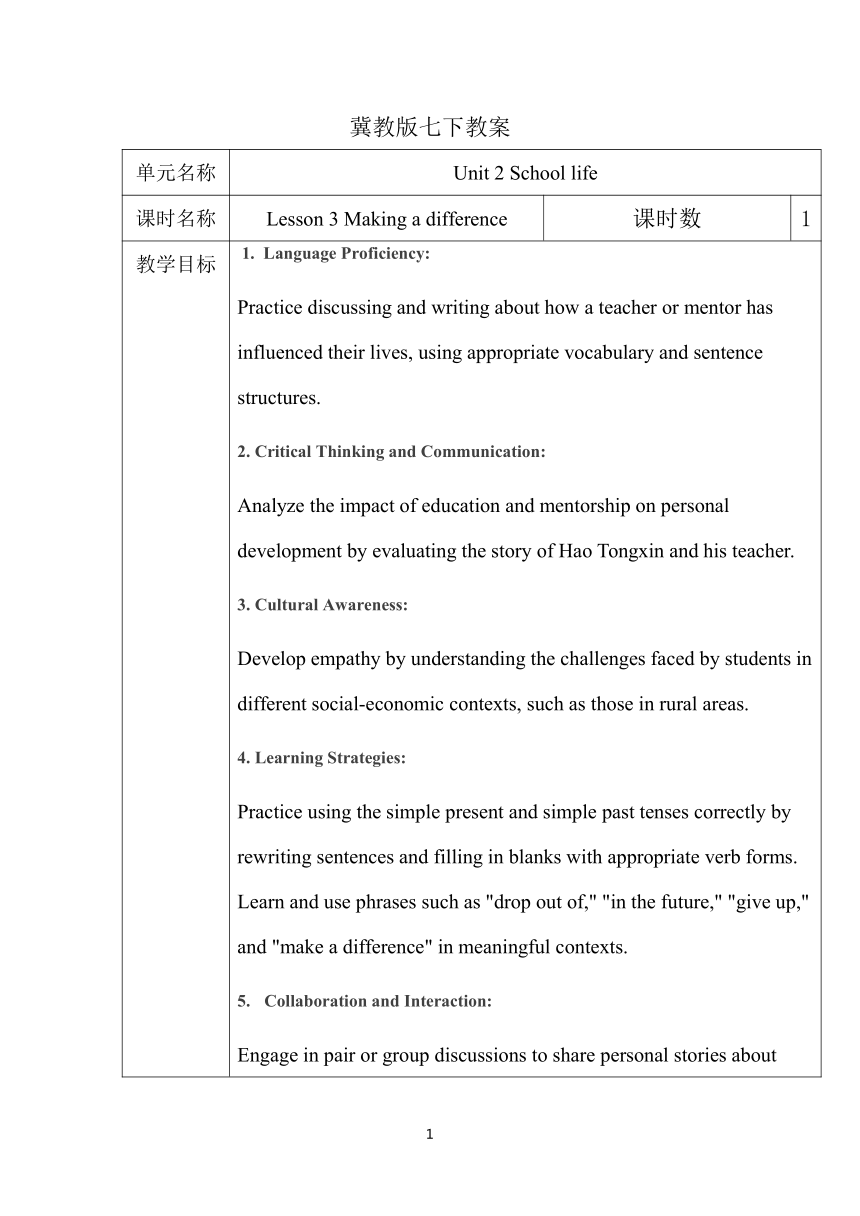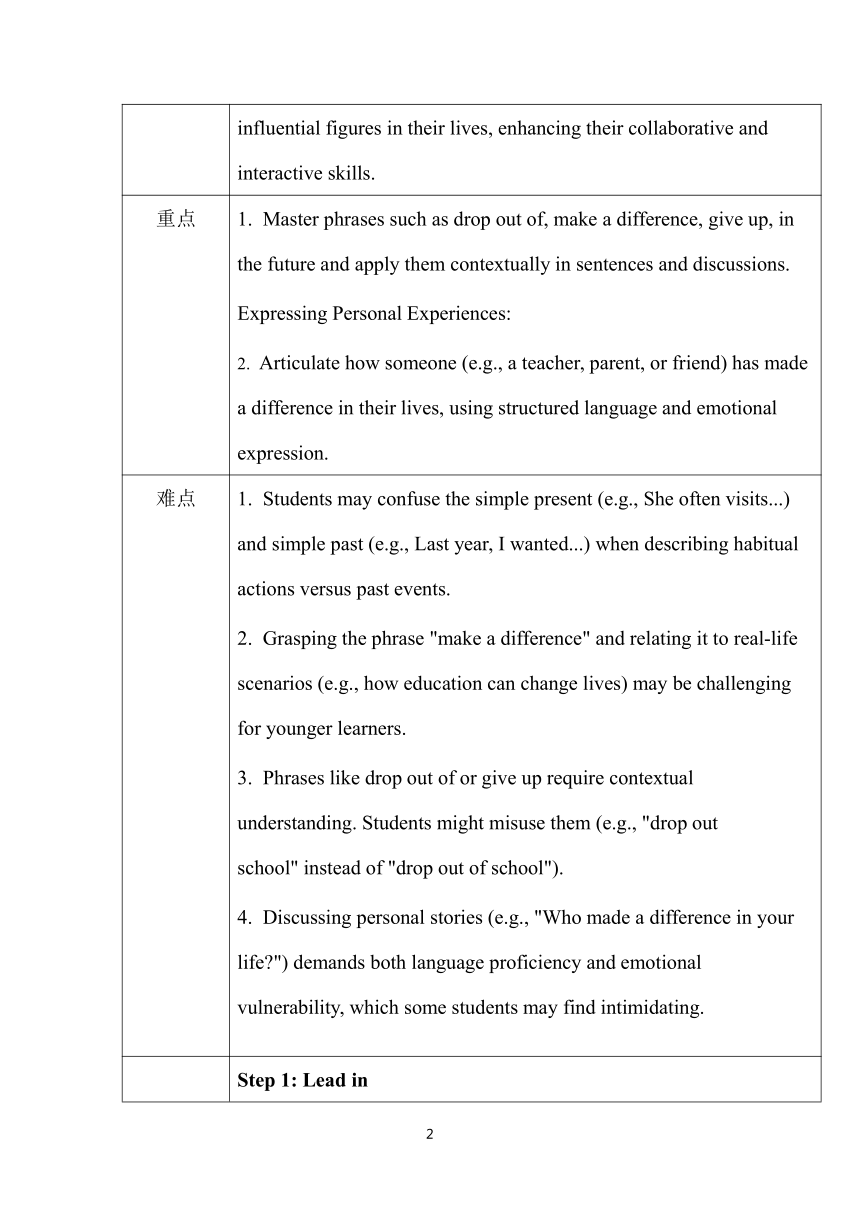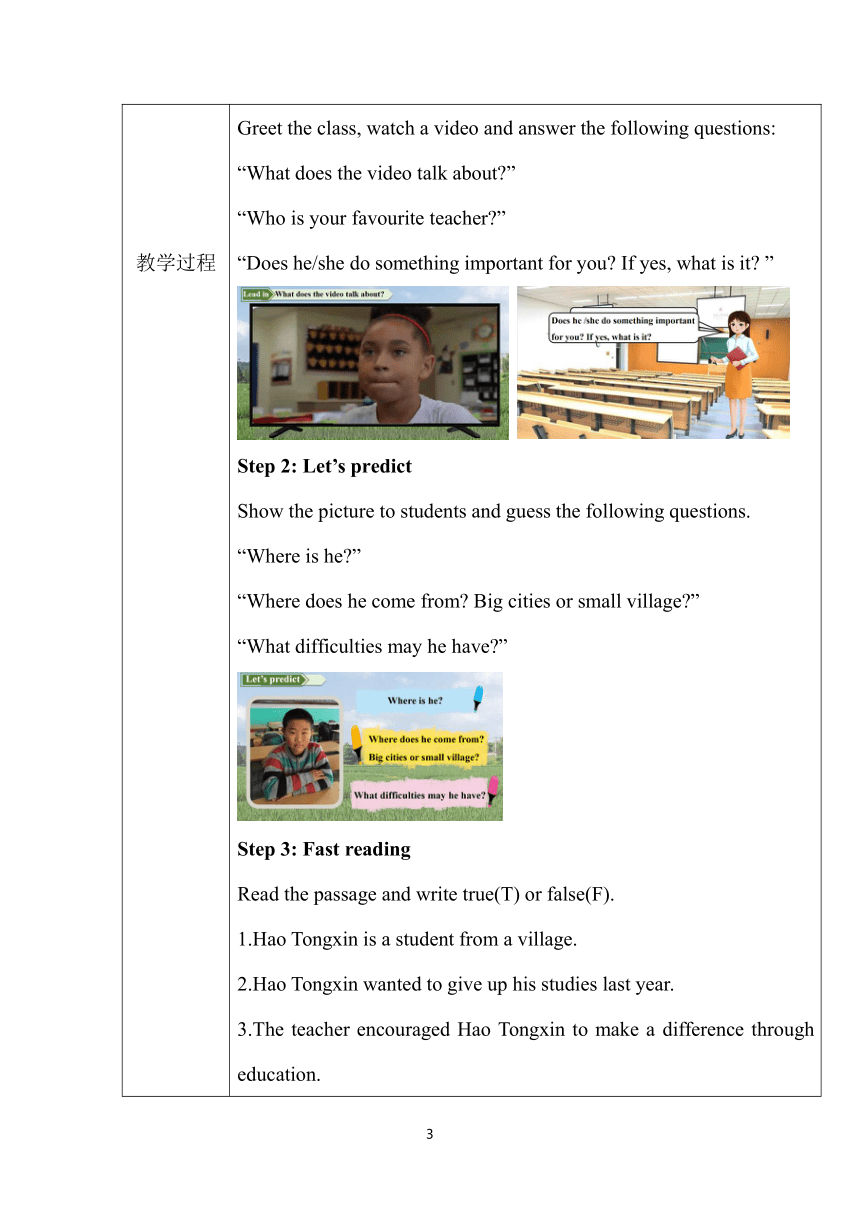Unit 2 Lesson 3 Making a difference教案-新冀教(2024)七下
文档属性
| 名称 | Unit 2 Lesson 3 Making a difference教案-新冀教(2024)七下 |  | |
| 格式 | docx | ||
| 文件大小 | 3.3MB | ||
| 资源类型 | 试卷 | ||
| 版本资源 | 冀教版 | ||
| 科目 | 英语 | ||
| 更新时间 | 2025-02-19 09:00:29 | ||
图片预览




文档简介
冀教版七下教案
单元名称 Unit 2 School life
课时名称 Lesson 3 Making a difference 课时数 1
教学目标 Language Proficiency: Practice discussing and writing about how a teacher or mentor has influenced their lives, using appropriate vocabulary and sentence structures. 2. Critical Thinking and Communication: Analyze the impact of education and mentorship on personal development by evaluating the story of Hao Tongxin and his teacher. 3. Cultural Awareness: Develop empathy by understanding the challenges faced by students in different social-economic contexts, such as those in rural areas. 4. Learning Strategies: Practice using the simple present and simple past tenses correctly by rewriting sentences and filling in blanks with appropriate verb forms. Learn and use phrases such as "drop out of," "in the future," "give up," and "make a difference" in meaningful contexts. Collaboration and Interaction: Engage in pair or group discussions to share personal stories about influential figures in their lives, enhancing their collaborative and interactive skills.
重点 Master phrases such as drop out of, make a difference, give up, in the future and apply them contextually in sentences and discussions. Expressing Personal Experiences: Articulate how someone (e.g., a teacher, parent, or friend) has made a difference in their lives, using structured language and emotional expression.
难点 Students may confuse the simple present (e.g., She often visits...) and simple past (e.g., Last year, I wanted...) when describing habitual actions versus past events. Grasping the phrase "make a difference" and relating it to real-life scenarios (e.g., how education can change lives) may be challenging for younger learners. Phrases like drop out of or give up require contextual understanding. Students might misuse them (e.g., "drop out school" instead of "drop out of school"). Discussing personal stories (e.g., "Who made a difference in your life ") demands both language proficiency and emotional vulnerability, which some students may find intimidating.
教学过程 Step 1: Lead in Greet the class, watch a video and answer the following questions: “What does the video talk about ” “Who is your favourite teacher ” “Does he/she do something important for you If yes, what is it ” Step 2: Let’s predict Show the picture to students and guess the following questions. “Where is he ” “Where does he come from Big cities or small village ” “What difficulties may he have ” Step 3: Fast reading Read the passage and write true(T) or false(F). 1.Hao Tongxin is a student from a village. 2.Hao Tongxin wanted to give up his studies last year. 3.The teacher encouraged Hao Tongxin to make a difference through education. 4.Hao Tongxin didn't take the teacher's advice in the end. (Purpose: Through fast reading, students' ability to quickly grasp the information in the text is trained.) Step 4: Careful reading Read Paragraph 2-3 and answer the following questions. (Purpose: By closely reading the key paragraphs of the article, it helps students enhance their understanding of the text and lays a foundation for the later emotional sublimation of the article.) Step 5: Post reading Activity 1 Read the passage again and complete the story mountain. (Purpose: Retelling the text aims to improve students' overall summarization ability, laying a linguistic foundation for their comprehensive understanding of the text later.) Activity 2 After story mountain, evaluate Hao Tongxin’s teacher. Then introduce a teacher around us. Think about what the teacher do to have a great influence on students. (Purpose:By re-reading the text and completing a story mountain, develop students' ability to summarize and critical thinking.) Activity 3 After learning about Hao Tongxin’s teacher and Miss Zhang, who made a difference in your life. Discuss with your partner. Activity 4 Exercise Pay attention to the phrases in the passage and finish the exercise. Step 6: Language points Step 7: Grammar Read the passage again and pay attention to the parts in yellow.Explain the definition of the simple past tense to students in the form of an animation. Step 8 Exercises Finish the exercises on PPT. Step 9 Homework Basic Assignments Find the newly - taught phrases in the text and organize them in your notebook. Organize the sentences related to the teacher helping Hao Tongxin and describing the teacher in your notebook. Practical Assignments Imitate the structure and content of the article, and write a short passage about how you changed after being encouraged by someone. The passage should be about 50 - 60 words. You need to use the key words in the article and at least one of the sentence patterns you've just practiced. Extended Assignments Interview your classmates or friends around you. Ask them if they have ever wanted to give up in their study or life, what they thought at that time, and what made them persevere later. Organize the interview results into a simple report in English. The report should include the situations of at least 2 interviewees.
板书设计
教学反思 The lesson on "Making a Difference" resonated well with students, as it focused on the impact of teachers and education, a topic they could relate to. Students were engaged in discussing their favorite teachers and how they have influenced their lives. However, some students struggled to articulate specific ways their teachers have helped them, indicating a need for more guided prompts or examples to help them express their thoughts. The reading passage about Hao Tongxin and his teacher was effective in teaching the importance of perseverance and education. Students were able to identify true and false statements accurately, showing good comprehension. However, a few students had difficulty understanding the deeper message about making a difference. To address this, I will incorporate more discussion questions that encourage critical thinking and personal reflection. The lesson successfully introduced the distinction between the simple present and simple past tenses. Students practiced rewriting sentences by changing the tense, which helped reinforce their understanding. However, some students still confused the two tenses, particularly when dealing with irregular verbs. In future lessons, I will include more exercises and visual aids to clarify these grammar points.
单元名称 Unit 2 School life
课时名称 Lesson 3 Making a difference 课时数 1
教学目标 Language Proficiency: Practice discussing and writing about how a teacher or mentor has influenced their lives, using appropriate vocabulary and sentence structures. 2. Critical Thinking and Communication: Analyze the impact of education and mentorship on personal development by evaluating the story of Hao Tongxin and his teacher. 3. Cultural Awareness: Develop empathy by understanding the challenges faced by students in different social-economic contexts, such as those in rural areas. 4. Learning Strategies: Practice using the simple present and simple past tenses correctly by rewriting sentences and filling in blanks with appropriate verb forms. Learn and use phrases such as "drop out of," "in the future," "give up," and "make a difference" in meaningful contexts. Collaboration and Interaction: Engage in pair or group discussions to share personal stories about influential figures in their lives, enhancing their collaborative and interactive skills.
重点 Master phrases such as drop out of, make a difference, give up, in the future and apply them contextually in sentences and discussions. Expressing Personal Experiences: Articulate how someone (e.g., a teacher, parent, or friend) has made a difference in their lives, using structured language and emotional expression.
难点 Students may confuse the simple present (e.g., She often visits...) and simple past (e.g., Last year, I wanted...) when describing habitual actions versus past events. Grasping the phrase "make a difference" and relating it to real-life scenarios (e.g., how education can change lives) may be challenging for younger learners. Phrases like drop out of or give up require contextual understanding. Students might misuse them (e.g., "drop out school" instead of "drop out of school"). Discussing personal stories (e.g., "Who made a difference in your life ") demands both language proficiency and emotional vulnerability, which some students may find intimidating.
教学过程 Step 1: Lead in Greet the class, watch a video and answer the following questions: “What does the video talk about ” “Who is your favourite teacher ” “Does he/she do something important for you If yes, what is it ” Step 2: Let’s predict Show the picture to students and guess the following questions. “Where is he ” “Where does he come from Big cities or small village ” “What difficulties may he have ” Step 3: Fast reading Read the passage and write true(T) or false(F). 1.Hao Tongxin is a student from a village. 2.Hao Tongxin wanted to give up his studies last year. 3.The teacher encouraged Hao Tongxin to make a difference through education. 4.Hao Tongxin didn't take the teacher's advice in the end. (Purpose: Through fast reading, students' ability to quickly grasp the information in the text is trained.) Step 4: Careful reading Read Paragraph 2-3 and answer the following questions. (Purpose: By closely reading the key paragraphs of the article, it helps students enhance their understanding of the text and lays a foundation for the later emotional sublimation of the article.) Step 5: Post reading Activity 1 Read the passage again and complete the story mountain. (Purpose: Retelling the text aims to improve students' overall summarization ability, laying a linguistic foundation for their comprehensive understanding of the text later.) Activity 2 After story mountain, evaluate Hao Tongxin’s teacher. Then introduce a teacher around us. Think about what the teacher do to have a great influence on students. (Purpose:By re-reading the text and completing a story mountain, develop students' ability to summarize and critical thinking.) Activity 3 After learning about Hao Tongxin’s teacher and Miss Zhang, who made a difference in your life. Discuss with your partner. Activity 4 Exercise Pay attention to the phrases in the passage and finish the exercise. Step 6: Language points Step 7: Grammar Read the passage again and pay attention to the parts in yellow.Explain the definition of the simple past tense to students in the form of an animation. Step 8 Exercises Finish the exercises on PPT. Step 9 Homework Basic Assignments Find the newly - taught phrases in the text and organize them in your notebook. Organize the sentences related to the teacher helping Hao Tongxin and describing the teacher in your notebook. Practical Assignments Imitate the structure and content of the article, and write a short passage about how you changed after being encouraged by someone. The passage should be about 50 - 60 words. You need to use the key words in the article and at least one of the sentence patterns you've just practiced. Extended Assignments Interview your classmates or friends around you. Ask them if they have ever wanted to give up in their study or life, what they thought at that time, and what made them persevere later. Organize the interview results into a simple report in English. The report should include the situations of at least 2 interviewees.
板书设计
教学反思 The lesson on "Making a Difference" resonated well with students, as it focused on the impact of teachers and education, a topic they could relate to. Students were engaged in discussing their favorite teachers and how they have influenced their lives. However, some students struggled to articulate specific ways their teachers have helped them, indicating a need for more guided prompts or examples to help them express their thoughts. The reading passage about Hao Tongxin and his teacher was effective in teaching the importance of perseverance and education. Students were able to identify true and false statements accurately, showing good comprehension. However, a few students had difficulty understanding the deeper message about making a difference. To address this, I will incorporate more discussion questions that encourage critical thinking and personal reflection. The lesson successfully introduced the distinction between the simple present and simple past tenses. Students practiced rewriting sentences by changing the tense, which helped reinforce their understanding. However, some students still confused the two tenses, particularly when dealing with irregular verbs. In future lessons, I will include more exercises and visual aids to clarify these grammar points.
同课章节目录
